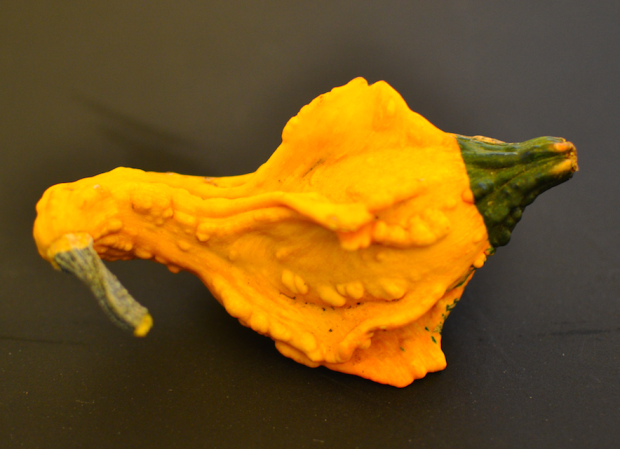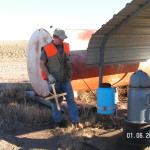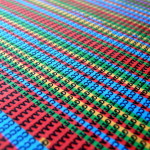Last weekend we made our annual trek to the pumpkin patch. While my kids scoured the field for their future jack-o-lanterns, I pursued a box of gourds, marveling at the variety. They were yellow, orange, green, white, round, bottlenecked, squat, elongated, smooth, undulated, and bumpy, in every permutation. I went for a twisty, warty, mostly yellow guy with wavy protrusions at the base.
If I was the crafty sort, I would have surfed over to Etsy for inspiration.
Instead, my scientist’s curiosity had me wondering, what was this thing?
The short answer is Cucurbita pepo. But search for that species in a seed catalog and you’ll get not just decorative gourds, but pumpkins, squash and zucchini. From a biologist’s view, these are all the same plant. Obviously, humans have been breeding C. pepo for some very diverse and specific characteristics, and not just in recent times. Turns out, this humble Thanksgiving centerpiece was one of the first plants cultivated by prehistoric humans.
It’s hard to look at my gourd and think zucchini. There are so many plants that look exactly alike, save for a slight differences in flower count or leaf shape. This is because in nature, plants evolve by chance, while in the garden, plants evolve by choices. The gardener chooses which plants to mate and which seeds to save. C. pepo conveniently has both male and female flowers on the same plant. This means the father is the mother – inbreeding is a great way to get a particular look or taste in most or all of the offspring.
In 1997 a paper in the journal Science examined the remains of C. pepo gourds and seeds found in an ancient cave settlement (8000 to 10,000 years old) in what is now Mexico. The rinds were a bit thicker and the shapes a bit longer than the wild gourds of today. So the gourds had been growing in these early human’s gardens long enough to be slightly different than what was found in the wild.
So, maybe more than 10,000 years ago, there were small, inedible domesticated C. pepo. But how did those gourds become the tasty squash, pumpkins and zucchini? And what about my gourd? Did humans select those earliest gourds for their more decorative elements? Or was it a more recent mutation turning a pumpkin inedible but pretty?
Traditionally, naturalists armed with exquisite drawing skills carefully detailed an organism, think of those beautiful plate illustrations of plants. Then, by comparing the flowers, leaves, stems, fruit, and roots of several plants they would propose an evolutionary relationship.
DNA analysis isn’t nearly so pretty. By lining up strings of DNA letters and counting the matches and mismatches we can come up with a number that measures the relationship distance between the two related organisms. Looking at these comparisons gets repetitive fairly quickly. But this boring uniformity is also its strength. Everything alive relies on DNA, so we can now tell how closely humans are related to pine trees. We can’t compare needles to hair, but our cells behave similarly and the DNA encoding for the cell machinery can be compared. Using this technique, scientists have been able to estimate the relationships between pretty much every major division of organisms out there.
The DNA-based technique also works for closely related organism where not enough time has passed for differences to build up in DNA encoding fundamental cell machinery. In C. pepo the obviously different genes for taste and looks were heavily selected for, so the DNA sequences of these features might not match the true, measurable relationship between the plants. In these cases scientists might target the purely random parts of the DNA. Because these regions of the DNA don’t have a function, they can change noticeably in a short time, say less than 10,000 years.
In an extremely dense paper that used these random bits of DNA, I found a relationship tree between the different C. pepo. Even before humans started planting them, there was a split resulting in the three present-day subspecies. From one of these came pumpkins and squash and zucchini. Another one was a mix of wild, domesticated gourds and more squash. And the third went unnoticed by humans, it still grows wild in Mexico.
Looking at the tree, I can find the branch with the domesticated gourds and see that it’s pretty far from zucchini (unsurprisingly) and pumpkins. And at further subdivisions, it’s the scallop and crookneck squash that are closest to the wild gourds. That seems odd, and makes me wish I could extract my own gourd’s DNA and upload it to the tree to see exactly where it ends up.
But I think I’ll have to wait for DNA sequencing costs to go down a bit more before I can take up that project in my spare time.
Smith, Bruce D. “The initial domestication of Cucurbita pepo in the Americas 10,000 years ago.” Science 276.5314 (1997): 932-934.
Paris, Harry S., et al. “Assessment of genetic relationships in Cucurbita pepo (Cucurbitaceae) using DNA markers.” Theoretical and Applied Genetics 106.6 (2003): 971-978.









Comments are closed.